How can museums use Disaster Risk Reduction approaches, to safeguard themselves, and enhance their contributions to the wider world?
This Guide was produced in 2019 to support museums and their partners to draw on Disaster Risk Reduction approaches as they 'reshape' and make decisions as they emerge from the pandemic. The Guide can be accessed here.

Disasters – crises, emergencies, damaging situations – come in many shapes and sizes. Reducing their occurrence and their impact is a key part of good management, and securing a future that is better than the present. Disaster Risk Reduction is not just about surviving disasters, but working to reduce the likelihood of disasters happening in the first place, being prepared for them when they hit, recovering from them as best you can, and coming out the other side stronger. Everyone can benefit from Disaster Risk Reduction approaches, and everyone can use them, in their own lives and in their work.
This Guide aims to help empower museums (small, large and of any kind, anywhere), museum workers, museum networks and their partners to draw on Disaster Risk Reduction approaches. This should help them reduce the impact of disasters, whether COVID-19, climate change, or any other kind of disaster, for the benefit of themselves, their communities, and the natural environment.
So, the Guide has two main goals:
To help museums build their resilience, and reduce the impact of disasters on museums themselves.
To help museums contribute to resilience-building in the wider world, for the benefit
of society and the natural environment.
Many museums already consider disaster risk in terms of protecting their own buildings and collections. This Guide takes a broader perspective, that museums can play a key role in supporting people, communities, the whole of society and nature, to prevent or mitigate disasters in the wider world. Making a difference in the world is, arguably, the best way for museums to be resilient as organizations.
The Guide aligns museum activities with the Ten Essentials of Resilience, an existing international framework for localising Disaster Risk Reduction, linked to the Sendai Framework.
Climate change is presented as an example of how museums can contribute to climate action by aligning with the Ten Essentials of Resilience.
The Guide includes case studies on how museums are already embracing Disaster Risk Reduction.
